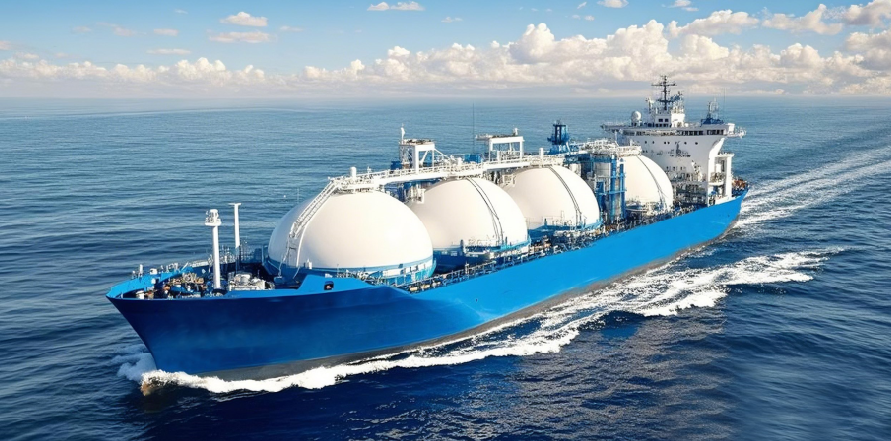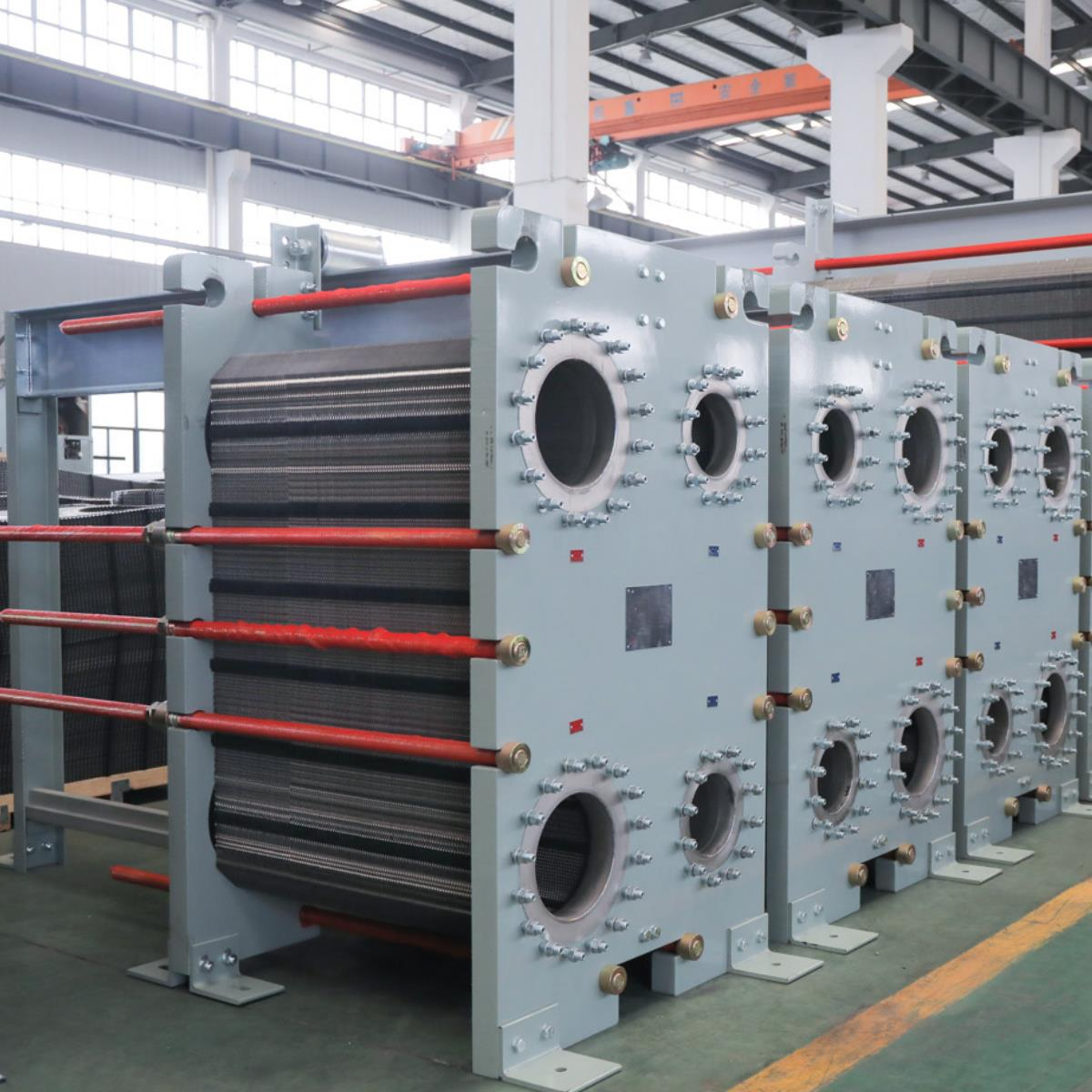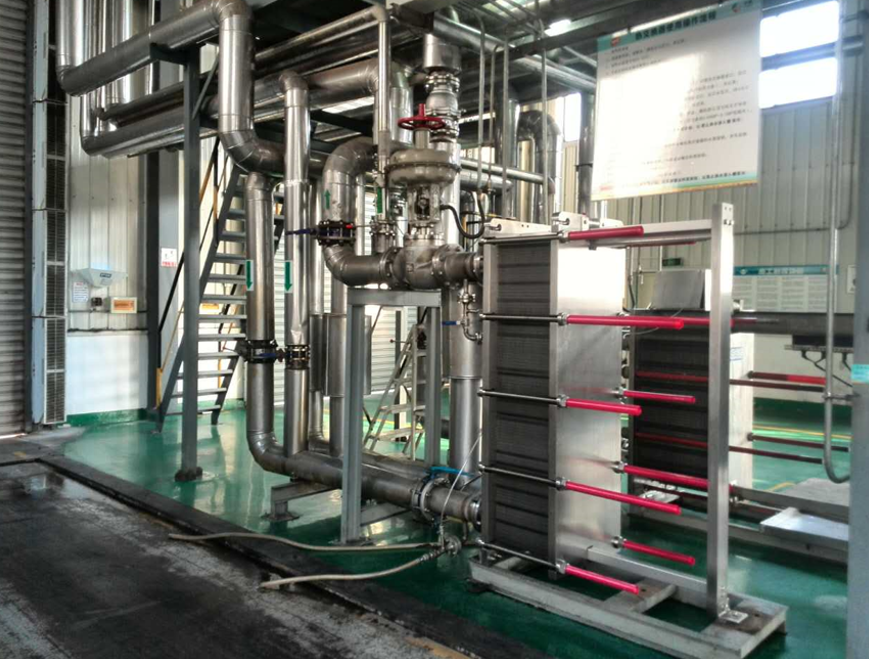Critical Roles of Plate Heat Exchangers in Modern Industries
Many industries need precise temperature control, often achieved using plate heat exchangers (PHEs). They transfer heat between two fluids using thin, corrugated metal plates stacked together. Hot and cold fluids flow in alternating channels, allowing rapid heat exchange without mixing. This design offers excellent thermal performance in a compact package, saving energy and space compared to traditional exchangers. Their adaptability and efficiency make PHEs a go-to solution for modern industrial thermal challenges, highlighting their importance in manufacturing, energy, and environmental industires.
1. Oil and Gas: Handling the Heat in Harsh Environments
The oil and gas industry operates under extreme conditions, involving high pressures, elevated temperatures, and often corrosive media. Efficient thermal management is paramount for safety, process optimization, and energy recovery. Plate heat exchangers find critical applications here, including:
·Crude Oil Processing: Pre-heating crude oil before it enters distillation columns and subsequently cooling various refined fractions like naphtha, kerosene, and diesel.
· Gas Treatment: Cooling compressed natural gas to remove liquids (dew point control), inter-stage cooling in multi-stage compression, and vital heat recovery in amine treating units used to remove H₂S and CO₂ (gas sweetening).
· LNG Production: Integral in the pre-cooling stages of liquefaction, helping to efficiently bring natural gas towards its cryogenic liquefaction temperature.
· Refinery Operations: Broad utility in cooling hydrocarbon streams, condensing overhead vapors from fractionators and reactors, reboiling duties, and recovering valuable heat from hot process fluids to preheat boiler feedwater or other streams.

The ability of industrial PHEs, particularly robust designs like fully welded plate heat exchangers, to handle demanding process conditions (high pressure/temperature cycles, potentially fouling fluids) while offering superior thermal performance makes them invaluable. Efficient thermal recuperation using HT-Bloc Welded Plate Heat exchangers directly translates to reduced fuel consumption and lower operational costs, a key economic and environmental driver in this energy-intensive industry. Explore tailored solutions for this sector at Heat Exchange Solutions for the Oil and Gas Industry.
2. Chemical Industry: Precision and Durability
Chemical processing involves a myriad of reactions, separations, and conditioning steps, nearly all requiring meticulous temperature control for yield, selectivity, and safety. Plate type heat exchanger provides the necessary precision and efficiency for:
· Heating and Cooling Reactants/Products: Precisely controlling reactor inlet temperatures, managing exothermic reaction heat, and safely cooling final products to storage or downstream processing temperatures.
· Vapor Condensation: Efficiently condensing overhead vapors from distillation columns, reactors, or evaporators, often under vacuum conditions where low pressure drop is crucial.
· Solvent Recovery: Recovering heat in solvent extraction loops and effectively condensing evaporated solvents for reuse, minimizing solvent losses and energy input.
· Handling Aggressive Media: Utilizing specialized plate materials (e.g., titanium, Hastelloy C-276, SMO 254, tantalum) allows PHEs to safely handle highly corrosive acids, bases, chlorides, and other challenging chemicals. Applications span bulk chemicals (ammonia, sulfuric acid), petrochemicals (olefins, aromatics), polymers, pharmaceuticals, and oleochemicals (fatty acids, esters). The strong industry drive towards process intensification – achieving higher throughput and efficiency with smaller, more integrated equipment – strongly favors the inherently compact and efficient nature of PHEs over traditional heat transfer equipment. Discover specific chemical applications at Heat Exchange Solutions for the Chemical Industry.
3. Metallurgy: Built for Extremes
Metallurgical processes often involve extreme heat generation, aggressive cooling requirements, and chemically harsh environments. Plate type heat exchangers demonstrate their resilience and effectiveness in applications such as:
· Furnace Cooling: Providing essential closed-loop cooling for critical components of electric arc furnaces (EAFs), induction furnaces, and blast furnaces, protecting panels, electrodes, and structural elements from overheating.
· Quenching Operations: Efficiently cooling quenching oils or water used for heat treating metals like steel and aluminum, ensuring consistent metallurgical properties.
· Acid Heating/Cooling: Managing temperatures in pickling lines (acid baths for surface cleaning) and electroplating or anodizing baths where precise temperature influences coating quality.
· Hydrometallurgy: Controlling temperatures in leaching circuits (dissolving metals from ores) and electrolyte circuits during electrowinning or electrorefining processes.
The stability required in these applications often necessitates welded or semi-welded PHE designs capable of handling high temperatures, thermal shock, and potentially fouling or abrasive fluids (e.g., cooling water with high solids content). Learn more about metallurgical heat exchange challenges at Heat Exchange Solutions for the Metallurgy Industry.

4. Renewable Energy: Powering the Transition
As the world transitions towards sustainable energy sources, plate heat exchanger play a crucial, often enabling, role in optimizing the efficiency and economic viability of these green technologies:
· Geothermal Energy: Extracting useful heat from geothermal brine (hot water/steam from underground) to heat fresh water for district heating systems or to vaporize a working fluid in Organic Rankine Cycle (ORC) power generation units.
· Solar Thermal: Efficiently transferring heat collected by solar panels (flat plate or concentrated) to thermal storage tanks or directly to distribution systems for hot water or space heating.
· Biofuel Production: Controlling temperatures during critical stages like biomass feedstock pre-treatment, enzymatic hydrolysis, fermentation (maintaining optimal microbial activity), and distillation for ethanol or biodiesel purification.
· Battery Thermal Management: Ensuring large-scale battery energy storage systems (BESS) operate within their optimal temperature window for performance, safety, and longevity, often using liquid cooling circuits incorporating PHEs.
· Waste Heat Valorization: Capturing low-grade (low temperature) waste heat from industrial processes, data centers, or even sewage, and using PHEs in conjunction with heat pumps to upgrade this energy for useful heating applications. Efficient heat transfer is absolutely fundamental to the overall energy balance and economic feasibility of many renewable and sustainable energy systems. See how PHEs contribute at Heat Exchange Solutions for the New Energy Industry.
5. Environmental Protection: Efficient, Sustainable Solutions
Environmental regulations and the growing emphasis on sustainability necessitate efficient resource management, particularly concerning water treatment and energy recovery from waste streams. Plate heat exchangers are key technologies in:
· Wastewater Heat Recovery: Extracting valuable thermal energy from treated municipal or industrial wastewater before discharge, significantly reducing the energy needed for heating incoming fresh water or other processes.
· Sludge Treatment: Heating sludge for anaerobic digestion (to enhance biogas production) or cooling it after thermal hydrolysis processes; also used in sludge drying applications.
· Flue Gas Condensation: Recovering both sensible and latent heat from boiler or incinerator flue gases by cooling them below the water dew point, boosting overall system efficiency significantly and potentially recovering condensed water.
· Industrial Effluent Cooling: Reducing the temperature of warm industrial discharges to comply with environmental regulations before release into rivers or sewers. These applications often involve challenging fluids with potential for fouling, but the high efficiency of Wide Gap Welded Plate Heat Exchanger in waste heat valorization makes them indispensable tools for sustainable industrial operations. Find solutions for environmental applications at Heat Exchange Solutions for Environmental Protection Industry.
6. Offshore Industry: Compact and Corrosion-Resistant
Space and weight are always critical constraints on offshore oil and gas platforms, FPSOs (Floating Production Storage and Offloading units), and other vessels. The inherently compact footprint and high efficiency-to-weight ratio of plate heat exchangers offer significant advantages in this demanding environment:
· Central Cooling Systems: Utilizing readily available seawater to cool various onboard systems (engines, hydraulics, HVAC) via an intermediate closed freshwater or glycol loop, protecting sensitive equipment from direct exposure to corrosive seawater. Titanium plate PHEs are standard for the seawater side.
· Engine Cooling: Providing reliable cooling for jacket water and lubrication oil circuits for main propulsion engines and auxiliary diesel generators.
· Hydraulic and Lubrication Oil Cooling: Maintaining optimal operating temperatures for essential machinery like cranes, winches, and thrusters.
· HVAC Systems: Serving as condensers or evaporators in air conditioning systems and providing heating water for accommodation modules. Material selection (titanium, SMO 254) and study, space-saving design are crucial for long-term reliability in the harsh, corrosive marine environment. Explore offshore solutions at Heat Exchange Solutions for the Offshore Industry.
7. Food and Beverage: Clean, Precise, Reliable
Perhaps one of the most visible and critical applications, the food and beverage industry relies heavily on plate heat exchangers specifically designed for hygienic operation and precise thermal control:
· Pasteurization and Sterilization: Rapidly heating products like milk, juice, beer, wine, soups, and sauces to kill microorganisms, followed by rapid cooling to preserve quality, flavor, and nutritional value (e.g., High-Temperature Short-Time - HTST, Ultra-High Temperature - UHT processing). Multi-section PHEs often incorporate regeneration, using the outgoing hot product to pre-heat the incoming cold product, saving significant energy.
· Wort Cooling: Quickly and efficiently cooling boiled wort (unfermented beer) down to the optimal temperature for yeast pitching in breweries, a critical step for controlling fermentation.
· Dairy Processing: Essential for milk reception cooling, cream heating/cooling for separation, yogurt incubation temperature control, and cheese milk pasteurization.
· Juice and Beverage Heating/Cooling: Adjusting temperatures for clarification, deaeration, filling, and carbonation processes.

Special "food-grade" heat exchanger feature highly polished stainless steel plates (low Ra surface finish), hygienic clamp connections (e.g., Tri-Clamp), FDA-compliant gaskets, and are specifically designed for easy and effective Cleaning-In-Place (CIP) and Sterilization-In-Place (SIP). The gentle product handling (low shear stress) and precise, uniform thermal treatment afforded by PHEs are vital for maintaining the delicate flavors, textures, colors, and nutritional integrity of food and beverage products. See food-specific applications at Heat Exchange Solutions for the Food Industry.
8. Power Generation: Reliable Auxiliary Cooling
Large-scale thermal power plants (coal, gas, nuclear) and smaller combined heat and power (CHP) units require dependable and efficient cooling systems for optimal performance, safety, and equipment longevity. Plate heat exchangers serve critical auxiliary roles:
· Turbine Systems: Cooling vital lubrication oil for bearings in large steam and gas turbines, as well as generator cooling systems.
· Closed-Circuit Cooling: Creating an intermediate barrier loop (using high-quality treated water) to cool critical components, isolating them from potentially corrosive or fouling raw cooling water sources (river, lake, sea). This protects expensive equipment like generators or transformers.
· Condenser Cooling: Used in smaller power plants or geothermal ORC cycles as the main condenser, or as part of secondary cooling loops in larger plants.
· District Heating Networks: Acting as the interface heat exchanger, transferring heat efficiently from the power plant's steam cycle or flue gas recovery system to the water circulating in the municipal district heating grid. High flow rates, thermal efficiency, low pressure drop, and unwavering reliability are paramount design considerations in this sector. Learn about power industry solutions at Heat Exchange Solutions for the Power Industry.
9. HVAC & Refrigeration: Everyday Efficiency
Though not detailed in the specific linked pages, it's impossible to discuss PHE applications comprehensively without mentioning the vast Heating, Ventilation, Air Conditioning, and Refrigeration (HVAC&R) sector. Here, PHEs (very often compact brazed plate heat exchangers - BPHEs, but also gasketed types PHE) are fundamental components:
· Chillers: Acting as highly efficient evaporators (cooling water/brine) and condensers (rejecting heat to cooling water or ambient air via a fluid loop).
· Heat Pumps: Facilitating the reversible transfer of heat between refrigerant circuits and water or brine circuits for both heating and cooling duties.
· District Heating/Cooling Substations: Serving as the interface in buildings, transferring thermal energy efficiently between the main district energy network and the building's internal heating or cooling system.
· Data Center Cooling: Providing efficient liquid cooling solutions, either directly cooling servers or as part of larger facility cooling loops, where space and energy efficiency are critical.
Their compactness, high thermal performance, and low refrigerant charge requirements contribute significantly to the energy efficiency ratings (like EER, SEER, COP) of modern HVAC&R systems.
Common Questions Addressed
Why Choose PHEs Over Shell & Tube Exchangers?
The choice often hinges on specific application needs. PHEs typically offer significantly higher thermal efficiency (3-5 times higher U-values), resulting in a much smaller physical footprint and lower weight for the same heat duty. They generally induce higher turbulence, leading to lower fouling tendency in many services, and gasketed types allow easy disassembly for inspection and cleaning. However, traditional shell-and-tube exchangers can generally handle much higher pressures and temperatures, are often considered more stable for severely fouling or high-viscosity fluids, and can be designed with larger flow passages to minimize pressure drop in gas services.
Are PHEs Suitable for High Pressures and Temperatures?
It depends critically on the PHE type. Standard gasketed PHEs have pressure and temperature limits determined by the frame design and, more importantly, the elastomer gasket material (e.g., NBR up to ~110°C, EPDM up to ~150°C, Viton up to ~180°C). Brazed PHEs (where plates are furnace-brazed, typically with copper) eliminate gaskets and can handle higher pressures (often 30-45 bar) and temperatures, common in refrigeration. Welded PHEs (using laser or plasma welding) offer the highest integrity, capable of handling very high pressures (over 100 bar) and temperatures (up to 350°C or more, depending on metal), making them suitable for demanding oil/gas, chemical, and high-temperature utility duties.
What Makes PHEs Ideal for Food Processing?
Their design facilitates precise, rapid heating and cooling with minimal residence time, crucial for preserving product quality and minimizing thermal degradation. More importantly, they can be manufactured to stringent hygienic standards using FDA-approved materials (stainless steel plates, specific gasket compounds), featuring highly polished surfaces (low Ra values) to prevent microbial adhesion, and designed for effective Cleaning-In-Place (CIP) and Sterilization-In-Place (SIP) protocols, ensuring food safety and regulatory compliance.
Selecting the most effective heat exchange solution is crucial for enhancing performance and reducing the operational costs of any thermal process. Grasping the various applications and fundamental advantages of plate heat exchangers is a vital initial step.
Shanghai Heat Transfer Equipment Co., Ltd. specializes in the design, manufacturing, installation, and service of plate heat exchangers and complete heat transfer systems.
If you need further consultation and discussion, please feel free to contact us.
Email: info@shphe.com
WhatsApp / Cell: +86 15201818405




